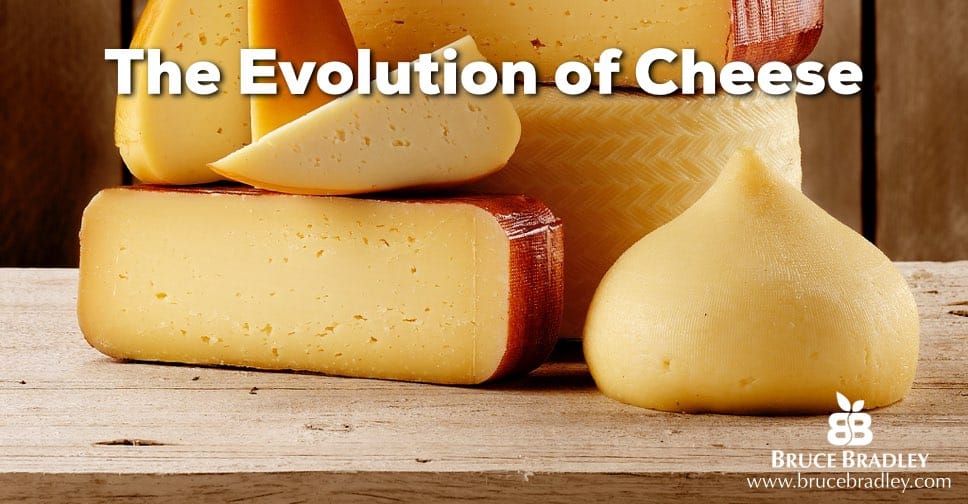 “What is cheese?” Seems like a pretty easy question, right? Unfortunately it may be much more difficult to answer than you might think since over the years a lot of changes have happened to what’s called cheese.
“What is cheese?” Seems like a pretty easy question, right? Unfortunately it may be much more difficult to answer than you might think since over the years a lot of changes have happened to what’s called cheese.
Although the exact origins of cheese are unknown, the process is believed to date back more than 4,000 years ago. Like many discoveries cheesemaking is believed to be the result of an accident that occurred when an Arabian merchant stored milk in a pouch made from a sheep’s stomach. When the rennet (an enzyme produced in the stomach of ruminant animals) combined with the milk and the warmth from the sun, violà—cheese was created.
Fast forward several millennia to the early 1800s and the art of cheesemaking had made a great deal of progress utilizing all different kinds of milk, cultures, and other natural ingredients to yield a wide variety of cheeses. Nonetheless, it was still a very hands-on, artisanal process almost exclusively conducted in homes or by local dairies. All that started to change in the mid 1800s when cheese factories began coming into vogue. But it wasn’t until the early 1900s that cheese started its evolution from real food to imposters like Velveeta “liquid gold.”
Looking back at the industrialization of cheese there were five defining moments that really changed how we think about cheese:
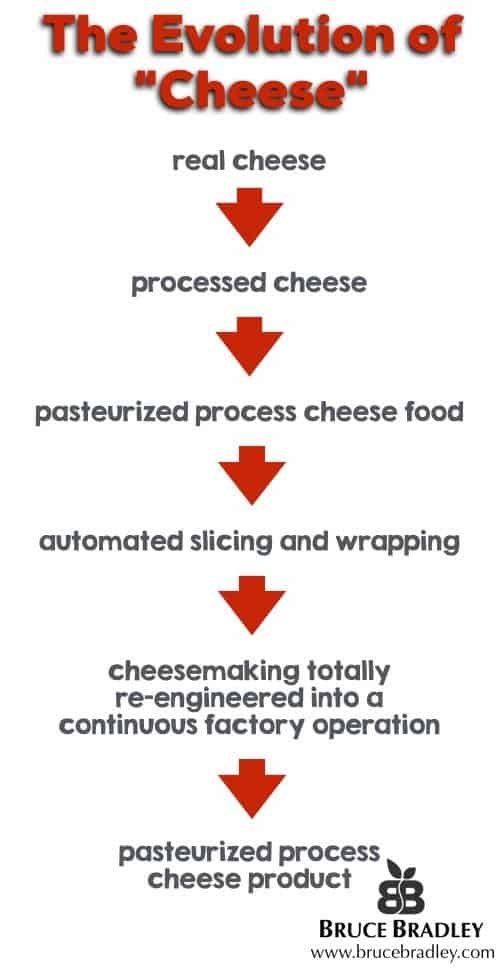 1915—The birth of processed cheese: James L. Kraft discovered that the constant stirring of cheese while warming kept it from separating. Additionally the resulting cheese didn’t have to be refrigerated, and it had a long shelf life. Although traditional cheese makers objected and called the product “embalmed” cheese, processed cheese was officially born.
1915—The birth of processed cheese: James L. Kraft discovered that the constant stirring of cheese while warming kept it from separating. Additionally the resulting cheese didn’t have to be refrigerated, and it had a long shelf life. Although traditional cheese makers objected and called the product “embalmed” cheese, processed cheese was officially born.
1928—Chemical additives make their way into cheese: Although this “innovation” wasn’t discovered by Kraft, it certainly changed how cheese was made, and before long, Kraft bought the Monroe Cheese Company, the original owner of Velveeta. What the Monroe Cheese Company discovered was that sodium phosphate (and later other chemical additives like potassium phosphate, tartrate, or citrate) acted as an emulsifier and prevented milk fats and proteins from separating. So basically chemical additions replaced the stirring process, and Velveeta was born. However, the issue with this processing method was that it doubled sodium levels in the processed cheese, not to mention all the flavor that was lost, resulting in a relatively tasteless, salty, milder cheese.
1940’s—Cheese gets sliced up: James L. Kraft’s brother created a chilled roller that rapidly cooled processed cheese, enabling machines to cut it into thin slices. By the 1960’s these slices were transformed yet again and wrapped in plastic, eventually becoming what’s now known as Kraft Singles.
1970’s—More additives, enzymes, and processing: The 1970’s ushered in the use of more enzymes which reduced production times by shortcutting the aging and flavoring process. By 1985 Kraft had totally re-engineered traditional cheesemaking, transforming it from an art that could take 18 months or more into a continuous, industrialized process that took less than a few days from beginning to end.
2003—The year some cheeses stopped being food: A 2003 FDA inspection of Kraft’s cheese plants revealed labels of Kraft Singles and Kraft Velveeta Cheese spread declared the use of MPC (Milk Protein Concentrates). MPCs don’t conform to the FDA’s standard of identity for cheese food. As a result Kraft decided to change the description for Kraft Singles and Velveeta from “pasteurized process cheese food” to “pasteurized process cheese product”—a collection of words for which the FDA has no standard of identity. Kraft escapes unscathed and continues to use MPC in many of its products to this day.
So what does all this mean? Well, let’s put this industrialized cheese product in context. If you check out a typical, real cheddar cheese label here’s what it looks like:
In contrast, let’s take a look at Kraft’s Velveeta label to see how all this “progress” translates into a so-called “cheese” product.
Here’s what concerns me with the ingredients of cheeses like Velveeta:
Milk, Whey, Skim Milk, Milkfat, and Cheese Culture: These dairy ingredients are most likely sourced from factory-farmed, industrial dairies where the routine use of growth hormones (like rBGH), antibiotics, GMO feeds, and inhumane conditions make them very problematic.
Milk Protein Concentrate (MPC) and Whey Protein Concentrate: These concentrates are typically cheap, imported, powdered by-products of industrial milk processing and are used by manufacturers like Kraft to drive cost-savings. Since MPCs are unregulated, have low/no tariffs, and don’t require any country of origin labeling, these cheap imports have proven very detrimental to domestic milk producers and provided a huge boon to food manufacturer profits. Due to the highly processed nature of these ingredients and their poor regulation (i.e. there’s huge potential for fraud similar to what happened with China’s melamine-tainted baby formulas), I try to avoid them!
Sodium Phosphate and Calcium Phosphate: Sodium phosphate is used as an emulsifier to keep the fats and proteins in cheese from separating, and calcium phosphate is most likely added as a way to fortify the calcium content of this “cheese-like” product. While in general these additives aren’t associated with much risk, the rampant use of phosphates in processed foods is increasingly concerning. In fact Rodale News reports, “Doctors are linking [phosphates] to higher rates of chronic kidney disease, weak bones, and premature death.”
Modified Food Starch, Maltodextrin, Dried Corn Syrup, and Canola Oil: First off, all of these ingredients are highly processed and are most likely sourced from GMO crops. Second, why do you need starches, sugars, and oil to make cheese? The reason is simple—Velveeta and “cheeses” like it aren’t really cheese. Rather, they are a conglomeration of milk-derived components that have been re-assembled, glued together, and flavored to resemble a cheese-like product.
Now completely unbridled by the FDA’s standards of identity, Kraft can practically write its own future when it comes to cheese and cost-savings. But are we truly eating cheese anymore? I don’t think so, do you? And who has won and who has lost during the industrialization of cheese? Certainly Kraft and other Big Food companies have won, making billions of dollars of profits over the years from processed cheese. But have consumers won? Have the inhumanely treated dairy cows won? Here’s my breakdown of the so-called “winners” and “losers” of cheap, processed “cheese.”
So if you eat cheese and other dairy products, what should you look for when shopping?:
- Avoid growth hormones like rBGH that have been banned in over 30 countries. Besides their potential link to higher levels of potentially cancer-causing hormones in our bodies, these growth hormones routinely lead to mastitis and other painful infections in cows treated with them. And although the FDA sticks to its well-lobbied guns by recommending growth hormone free milk/dairy products state “No significant difference in milk from cows treated with artificial growth hormones,” I personally avoid dairy products made from cows treated with growth hormones because they’re like a canary in the coal mine—indicative of a type of industrialized agriculture that I believe isn’t good for the cow, me, or the environment.
- Choosing organic is another way to avoid hormone-treated dairy products. An organic certification also ensures the cows are fed organic, non-GMO feed. Finally, organic options also help reduce or minimize the amount of pesticide and herbicide residues you may consume since these cows only consume organic certified feed or grass.
- Grassfed certification is yet one more step in the right direction and ensures cattle are fed grass or hay versus grains like corn. Since cattle are ruminant animals, their bodies are made for consuming grass, not grains. Cattle that are routinely fed grains like corn tend to be less healthy and often suffer from higher glucose levels and gastrointestinal problems like acidosis. Conversely grassfed cattle tend to have higher levels of beneficial fatty acids, vitamins, and antioxidants. Organic dairy products do not certify the cattle was grassfed so look for American Grassfed Association, Grassfed + USDA Process Verified, or Food Alliance Grassfed on labels to make sure you know what you’re paying for.
- Pastured is another consideration since pastured-raised cattle are not only more humanely treated, but they are much closer to truly natural conditions. Furthermore, a farm with a managed grazing process is much more sustainable. Finally, while organic standards require “access to pasture” there are a number of loopholes which large industrial feedlot dairies exploit. Therefore a pastured verification may address some concerns since technically cattle could be grassfed hay yet still be confined.
So while pastured, grassfed, organic is the gold standard, hopefully you can use this information to find better quality cheese and dairy products wherever you shop. You can also visit your local farmers market and talk to dairy farmers to learn more about where their products fit in. Finally, localharvest.org can be a great resource to help you find local dairy farmers that best match up with your food values!
Now that you’re armed with the inside scoop on cheese you may be thinking some of your favorite foods that use processed cheese are off-limits. No way! Stay tuned for my next post where I share my REAL FOOD, homemade version of queso. It’s got all of the taste you love with none of the junk!
Cheers!
Bruce
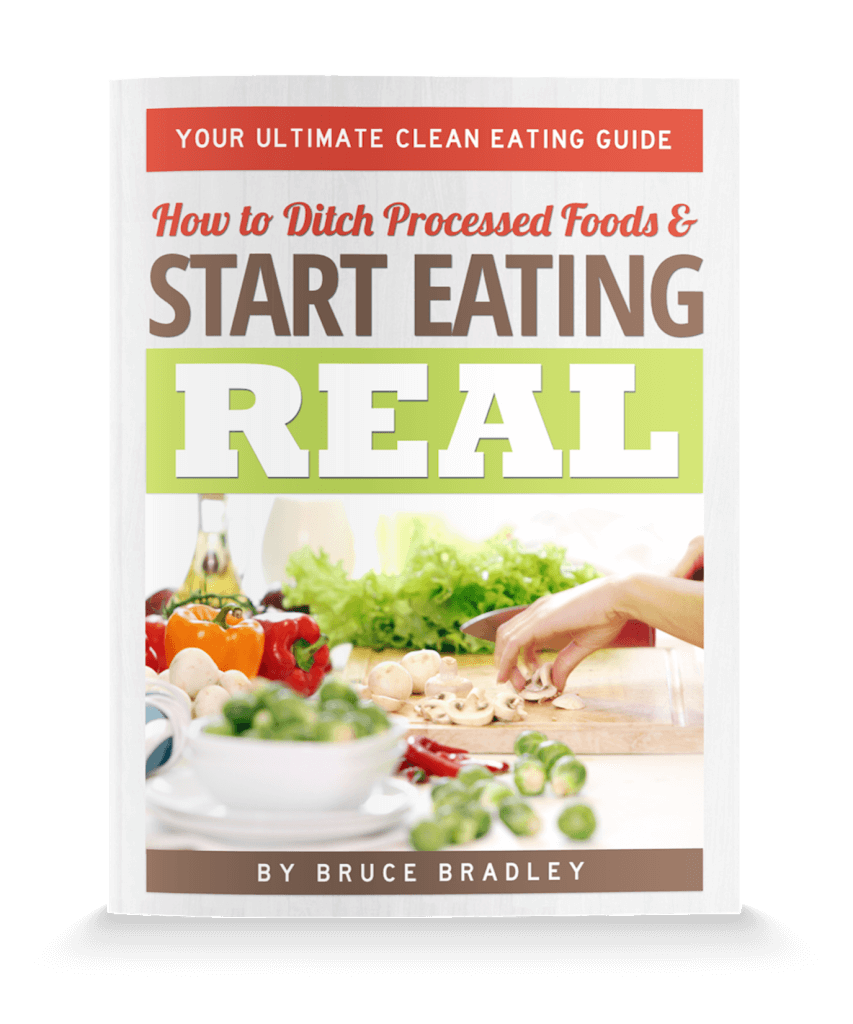
GET MY FREE BOOK NOW!
End the confusion! Learn what’s really in your food and how to take simple steps toward eating healthier!
EAT HEALTHIER TONIGHT!
If you enjoyed this article or recipe may I ask you a favor? Please share it with a friend. Why? Because together we can make a difference and help each other live happier and healthier lives. Thank you!

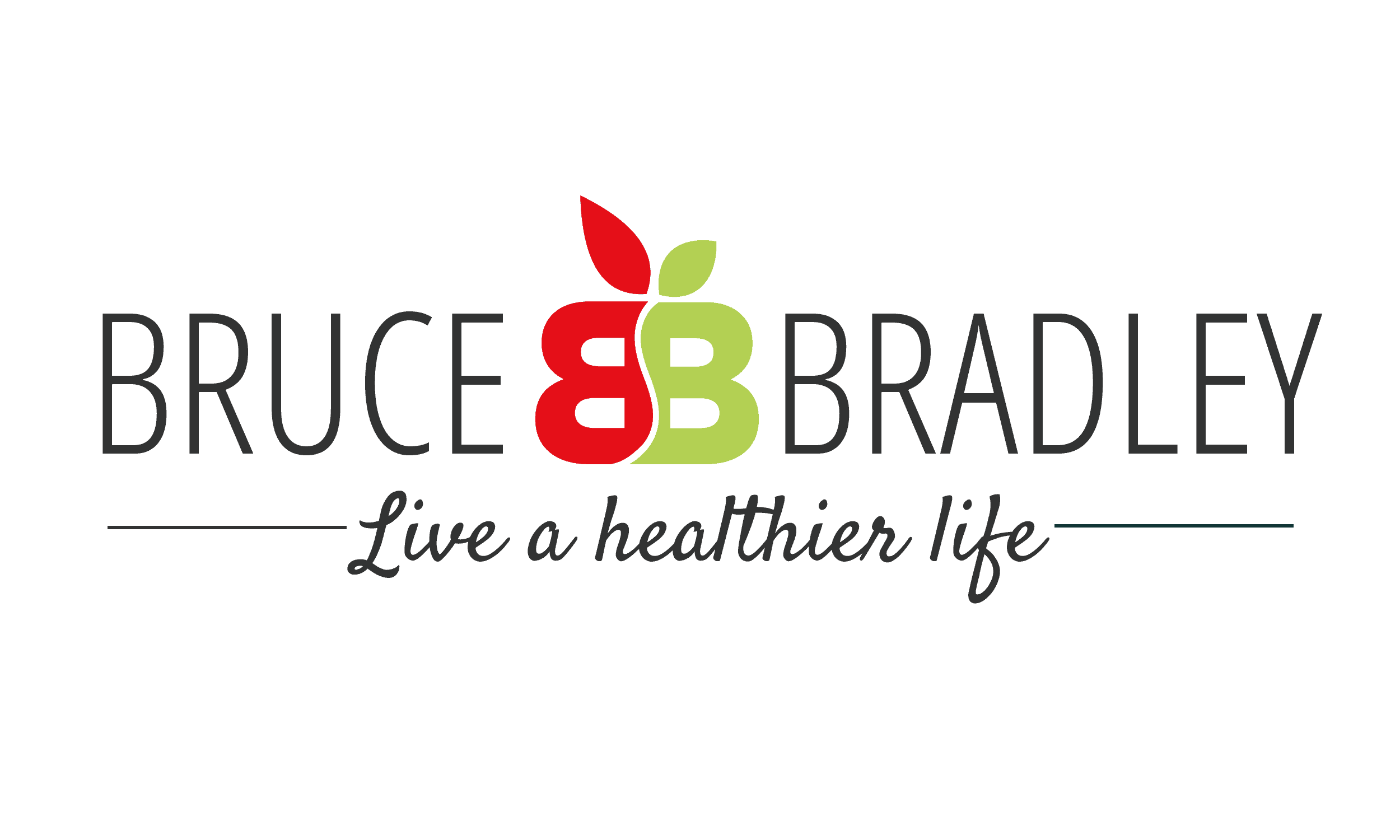
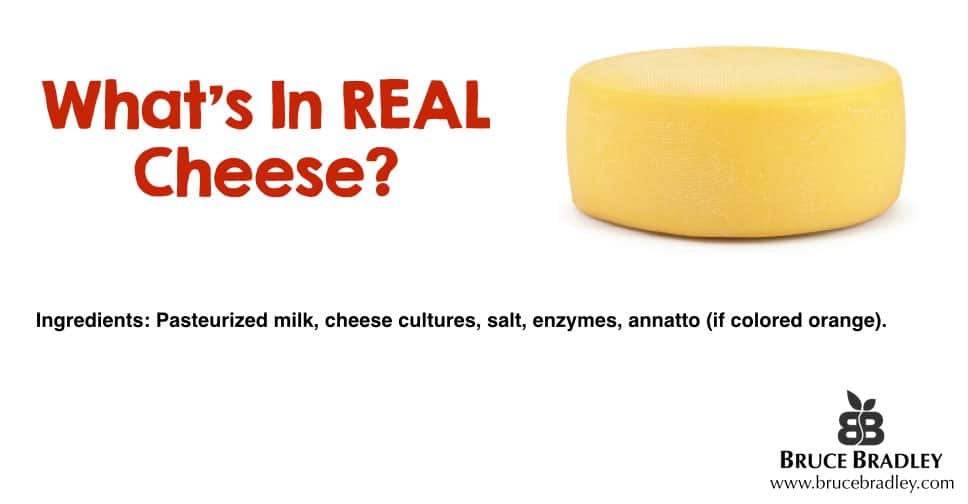
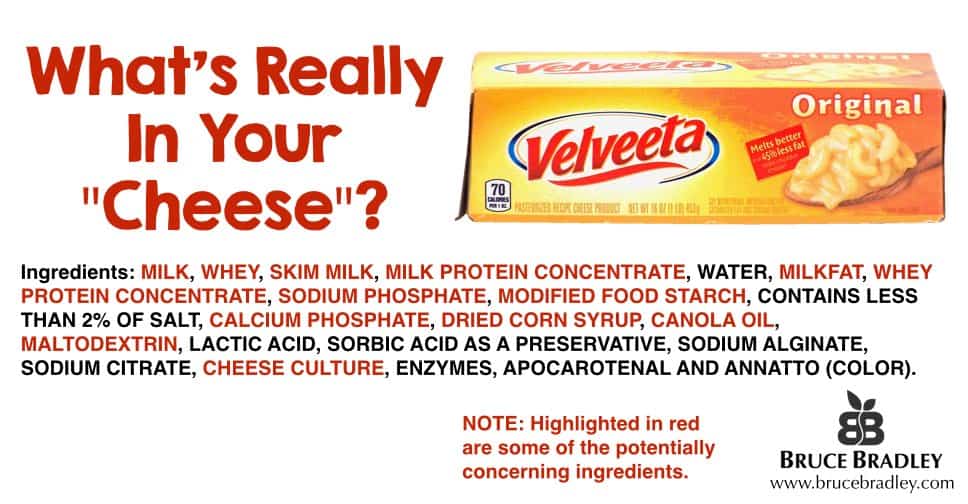
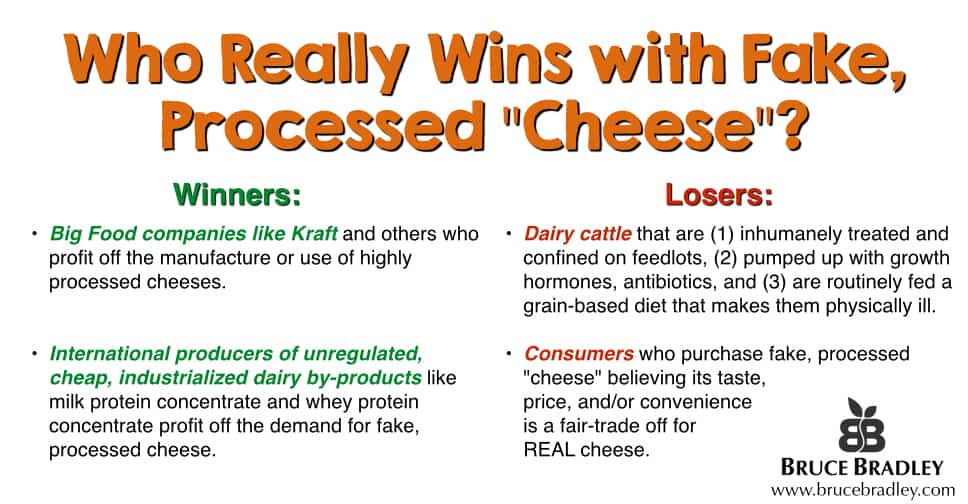

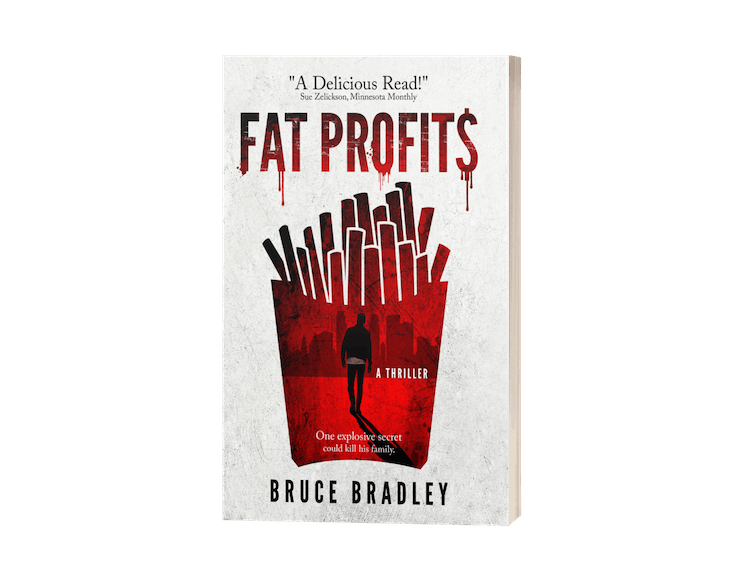
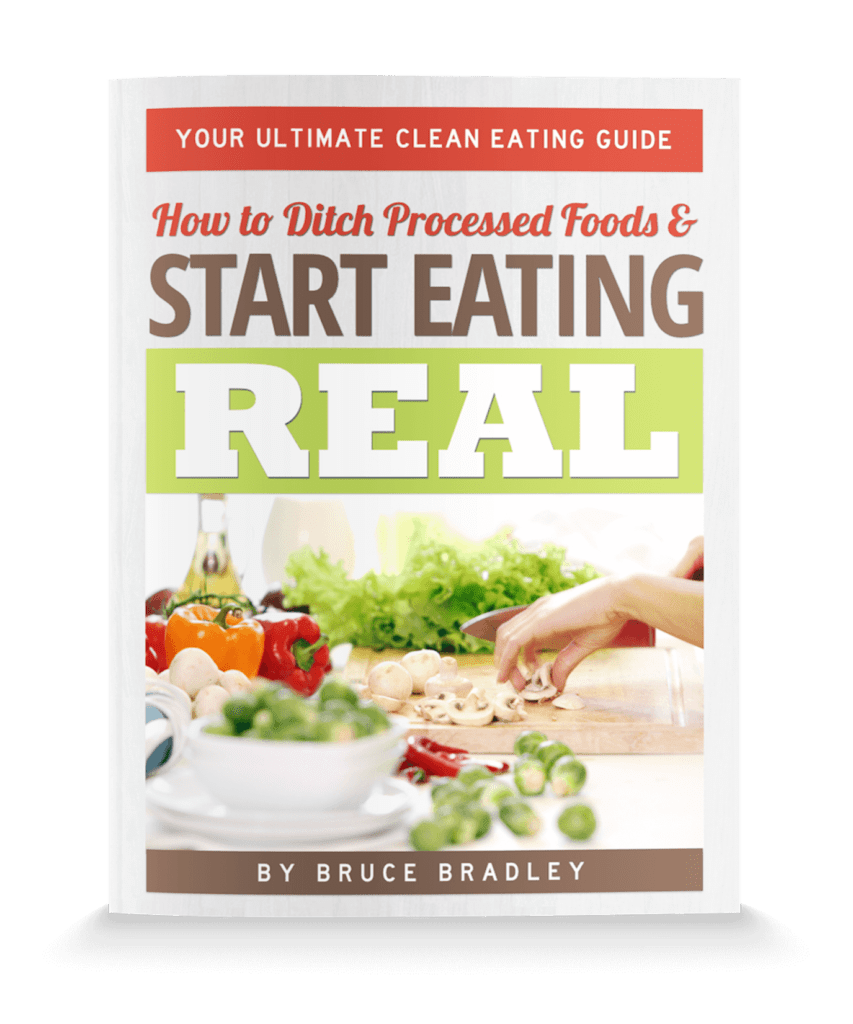
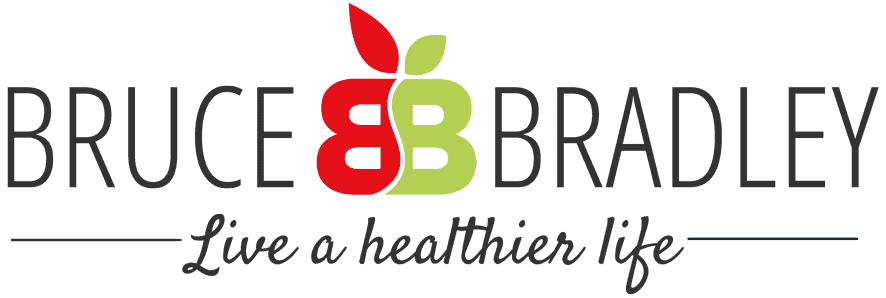
5 Responses
Since the 80s we’ve called Velveeta “Plasti-Cheese.” Can’t wait to see your version of Queso, but we have our own, too. Essentially, I make a cheese sauce (butter/flour roux, milk, real cheese) which we stir into the cooked meat and Ro-Tel. In fact, we are planning on having it this weekend.
Hi Lisa! Thanks for your comment!
“Plasti-Cheese”—great line! Perhaps spelling it “cheez” vs. cheese 🙂
FYI … my recipe for homemade, REAL queso is published. Enjoy!
Bruce
Consumers should also know that milk protein concentrate, or MPC, is usually imported and the origin is not disclosed on labels. MPC creates enormous economic hardship for small American dairy farmers when cheese processors substitute it for fresh milk in their products. Almost all the large “cheese” producers use MPC because it’s cheap. Buy real cheese from small regional companies–it tastes better, is better for you and your kids and better for your area farmers.
Thanks for the comment, Kathryn. I was trying to make that point too … perhaps a bit unsuccessfully. I rephrased one the sentences to try to hit it home a little bit more.
Thanks again!
Bruce
It is just possible that this reader did not read your original post carefully in her haste to make a point! 😉 It was –and is– a great article.